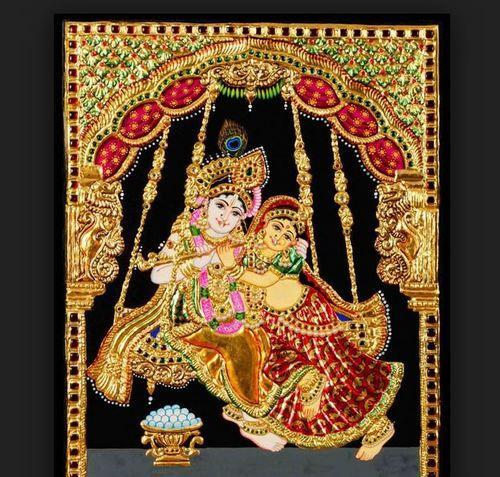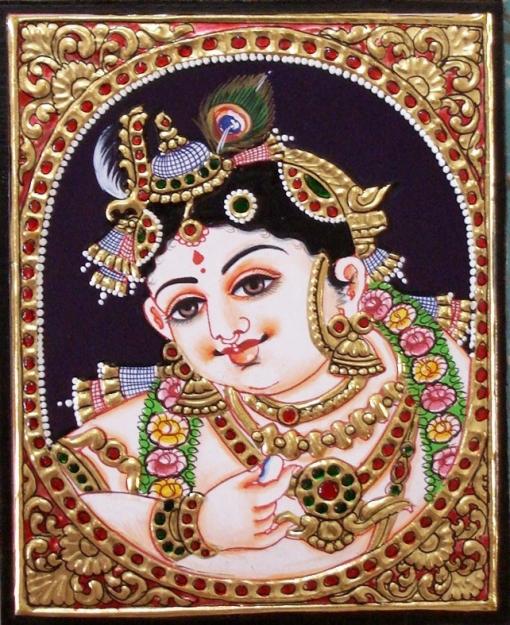- Home
- Culture of India
- Indian Paintings
- Tanjore Painting
Tanjore Painting
Tanjore Painting or Tanjavur Painting:
Tanjore painting or Tanjavur painting is the classical and beautiful paintings which originated in Tanjavur district of Tamil Nadu India. It originated around 16th century during Chola period. The Nayakas of Tanjavur gave huge importance to Indian art, dance, music and also paintings of Gods in the temples.
The main theme
of the painting was Hindu God and Goddess. There are also paintings from Hindu
Puranas, and other religious texts with the main figure are placed at the
centre of the picture. The rich vibrant colours used in Tanjavur painting makes
it different from other Indian Paintings.
Tanjavur
Paintings are done on a wooden plank known as panel painting (a painting made
on a flat panel made of wood either a single piece of wood or many pieces
joined together). Hence Tanjavur paintings are referred to as Palagai Padam
which means wooden plank picture. Tanjore painting uses very rich and vibrant
colours with glittering gold foils spread on it. Over a period of time many
changes have come in the paintings.
History and making of Tanjore Paintings
After the fall
of Vijayanagara Empire in the Battle of Talikot and the fall of Hampi most of
the painters who were present during Vijayanagara rule moved to different
places. Some people moved to Mysore and some to Tanjore. Painters who moved to
Mysore started with Mysore paintings and Painters who moved to Tanjore started
with Tanjore Paintings. The painters who moved to Tanjore started to work under
the Tanjavur Nayakas until the Nayakas were defeated by the Maratha rulers.
The Vijayanagara Empire which was founded by Harihara and Bukka were great lovers of art and literature. The art and literature reached its peak during Krishnadevaraya’s period. Tanjavur was established by Achutaraya who was the half brother of Krishnadevaraya. Sevappa ruled Tanjavur for many years along with his son Achyutappa.
During the reign of Achyutappa the mighty Vijayanagara
Empire fell and most of the painters moved to Mysore and Tanjavur. Later on
Achyutappa was succeeded by his son Raghunatha Nayaka and he was succeeded by
his son Vijayaraghava Nayaka.
With the fall
of Nayakas Venkoji who was the half brother of Chatrapati Shivaji went and
captured Tanjavur and established Maratha rule in Tanjavur. Serfoji II Bhonsle
who was the last ruler of Bhonsle Dynasty encouraged Tanjore paintings and
under his rule Tanjore Painting flourished and reached its peak.
Style and materials used for making Tanjore Paintings

It is
important for us to understand the procedure of making this marvellous
painting. It is little tedious and takes time to complete one painting but
after it is done one can really see the efforts and of course the beauty of the
painting.
The painting
is made on a canvas which is pasted on a wooden plank mostly of Jackfruit or
teak. It is then evenly coated with a paste of limestone and a binding medium.
It is allowed to dry. Ones the canvas is dried then it is ready for doing
painting of your choice. The artist then draws a detailed sketch of the main
and subsidiary characters in the painting.
For creating a
gesso work a paste made of Limestone and binding medium is used on the
painting. The next step is to beautify the painting for these gold leaves and gems
are used to beautify the main and the subsidiary paintings. These are used
mainly in the selected areas like pillars, arches, thrones and dresses. The
painting is ornamented with cut glass, pearls and even semi precious stones.
Laces or threads are also used to decorate the painting.
Finally bright
colours are applied on the sketch. Earlier the artists used natural colours
like vegetable dyes but now chemical paints are used instead of natural
colours. Red colour is usually used for background and green and blue is also
used.
Different
Hindu Gods were painted with different colours like Lord Vishnu was coloured
blue and lord Nataraja was coloured Chalk White. It is believed that the red
background is the trademark of Tanjore Painting. The portrayals in the
paintings are breath taking and beautiful. Most of the figures in the paintings
have rounded faces with Almond shaped eyes which is the unique character of
Tanjore Paintings.
Tanjore Paintings in Modern times
Over the time
Tanjore paintings are more improved and also the demand for this painting has
increased. Various exhibitions are held regularly by the government to support
the artists and the art. Even the materials that were being used in ancient
times have been changed to more easily available materials like the plywood has
taken the place of the Jack or teak wood that was previously being used.
Instead of natural colours some artists have started using synthetic colours.
Muck powder is used now to give 3D effect to the paintings.
Even though
the Tanjore paintings have taken a transformation still it is most gifted item
during the festival season in India. They are also used as a decorative item at
home.
Artists of Tanjore Painting
Tanjore
paintings were usually carried on by Jinigara community and the Nayudu
community of Madurai. They originally belonged to Telugu speaking community of
Rayalseema region in Andhra Pradesh. These artists later moved to Tanjore in
Tamil Nadu after the fall of Vijayanagara Empire. One of the famous calendar
artist and Tanjore painting artist was C. Kondiah Raju from Kovilpatti belonged
to Raju community.
C. kondiah Raju was a popular as calendar
artists who was famous for depictions of Hindu God and Goddess. He was born of
November 7th, 1898, at Chennai. C Kondiah Raju belonged to Raju
community which was famous for making Tanjore paintings. He worked for printers
like Sivakasi, and Madurai Raju worked for he died in the year 1976. His art mostly had the influence of Raja Ravi
Verma’s and also of Tanjore painting. C. Kondiah Raju’s paintings do have the
influence of Raja Ravi Verma’s paintings.
Please share your thoughts on Tanjore Painting here
Check out for other pages
Update on coronavirus in India
Affiliate Disclosure:
If you make any purchase via a link on this site, I may receive a small commission with no added cost to you.



